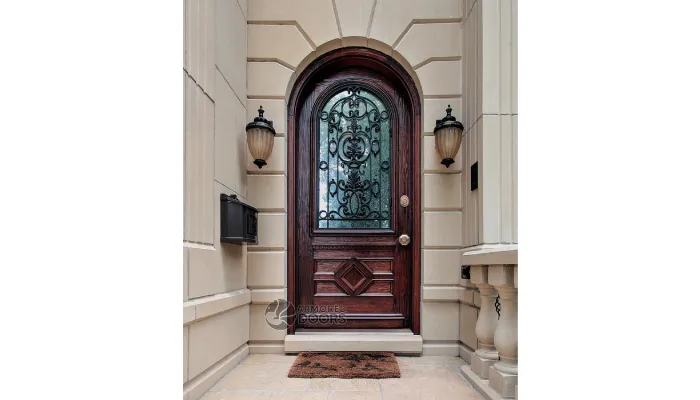
Safe Room Doors: What Makes Them Secure?
Safe room doors play an important role in protecting people and valuables from various threats like forced entry, fire, explosions, and severe weather. They are built using hardened steel, often layered with concrete or composite materials to resist cutting, drilling, and ballistic impacts. Fire resistance is commonly rated up to 1200°F for a few hours to provide added safety during emergencies. Security is enhanced by advanced locks, mechanical, electronic, or biometric, that include anti-tamper features. Doors usually meet strict standards such as FEMA P-361 and ICC 500 to ensure performance against natural disasters and attacks. Proper installation and regular maintenance are key to keeping these doors reliable over time.
Purpose and Roles of Safe Room Doors
Safe room doors serve as a critical barrier designed to protect people and valuables from a range of threats, including forced entry, fire, explosions, and severe weather. They are essential components in panic rooms, storm shelters, vaults, and secure storage areas within homes and businesses. The strength and features of these doors are tailored to the specific risks they face, whether that involves burglary attempts, ballistic attacks, or natural disasters. Beyond keeping intruders out, safe room doors also help contain hazards like fire and smoke, maintaining a safer environment inside. Their reinforced construction allows them to withstand attacks much longer than regular doors, providing occupants valuable time during emergencies. These doors maintain structural integrity by fitting tightly into reinforced frames, which supports the overall safety of the secure space. Many safe room doors are integrated with alarm and surveillance systems, adding an extra layer of protection through real-time monitoring and alerts. Additionally, they offer privacy and controlled access, preventing unauthorized entry into sensitive areas. By resisting tampering and breach attempts, properly designed safe room doors reduce vulnerabilities and act as the final line of defense when every second counts.
- Safe room doors create a strong barrier against forced entry, fire, explosions, and severe weather impacts.
- They are designed for use in panic rooms, storm shelters, vaults, and secure storage areas in homes and businesses.
- The door’s strength and features should reflect the threats anticipated, like burglary, ballistic attack, or natural disasters.
- They help contain hazards like fire and smoke while maintaining security from intruders.
- Safe room doors protect people and valuables by withstanding attacks longer than standard doors.
- They serve as the final line of defense in emergency situations, buying time for occupants.
- These doors support structural integrity by fitting tightly into reinforced frames.
- Safe room doors often integrate with alarm and surveillance systems for enhanced security.
- They can provide privacy and controlled access in sensitive areas, preventing unauthorized entry.
- Properly designed safe room doors reduce vulnerabilities in secure spaces by resisting tampering and breach attempts.
Materials Used in Safe Room Door Construction
Safe room doors are built primarily with reinforced steel, typically ranging from 1 to 6 inches in thickness. This steel is often combined with concrete or composite cores to create multi-layered structures that offer strong resistance against cutting, drilling, ballistic impacts, and explosions. Many high-quality doors use hardened steel alloys, which provide superior strength and durability, while the steel reinforcements are carefully welded and shaped to resist bending, prying, and blunt force. To meet fire safety standards like UL 72, fireproof materials capable of withstanding temperatures up to 1200°F for one to two and a half hours are integrated into the door design. Composite doors might include bulletproof steel finishes along with concrete infills, enhancing protection against a variety of threats. Beyond physical attacks, materials are selected to resist environmental hazards such as moisture and corrosion, often featuring special coatings that extend the door’s lifespan in humid or harsh conditions. Some safe room doors also incorporate soundproofing layers to reduce noise transmission and prevent information leakage, adding an extra layer of security during emergencies.
Types of Locking Mechanisms on Safe Room Doors
Safe room doors feature several locking mechanisms designed to match different security needs and threat levels. Mechanical locks use strong lever, pin, or tumbler systems operated by keys or combination dials. These locks are known for their durability and reliability without relying on power sources. Electronic locks offer keypad access and often support remote locking and unlocking, allowing integration with alarm or home automation systems. Biometric locks provide a higher level of security by using fingerprint or retina scans, ensuring only authorized individuals gain access. Some safe room doors combine these methods into dual locking systems, layering mechanical and electronic or biometric locks for enhanced protection. Lock components are reinforced with hardened steel to resist drilling, picking, and forced entry, while anti-tamper features help detect and prevent manipulation attempts. High-quality locks are often UL-certified by trusted brands, guaranteeing tested resistance to burglary efforts. Locking bolts extend into the door frame at multiple points, making prying attacks much harder to succeed. Many doors also include emergency override systems accessible only from the inside, allowing quick exit during emergencies without compromising security. Choosing the right locking system depends on factors like the expected threat, ease of use, and how well the lock integrates with other security measures in the safe room.
Security Levels and Protection Ratings Explained
Protection levels classify safe room doors based on their ability to resist forced entry, fire, and ballistic threats. Level II doors provide moderate security, making them suitable for typical residential settings; they also include reliable fire resistance for common household emergencies. Level V doors step up the protection by using enhanced materials and reinforced structures designed to withstand higher impact forces, fitting well in commercial environments or high-risk homes. At the top, Level VII doors offer maximum security with features like ballistic resistance, explosion-proof construction, and extended fire ratings up to 2.5 hours, ideal for government, military, and critical infrastructure. These protection levels correspond to rigorous testing and certification by recognized authorities, involving simulated attacks such as forced entry attempts, bullet impacts, and exposure to intense fire. Certification ensures that doors meet minimum standards for durability and protection, giving buyers confidence in their performance. Choosing the right security level depends largely on the expected threats and the specific occupancy needs. For example, a home in a tornado-prone area may prioritize doors rated to resist windborne debris and fire, while a panic room in a high-crime neighborhood might require ballistic resistance. Protection ratings provide a clear way to compare door performance and suitability, helping users match their security needs with tested capabilities.
Standards and Certifications for Safe Room Doors
Safe room doors gain their reliability largely through adherence to strict standards and certifications that verify their performance under extreme conditions. FEMA P-361 offers detailed guidance on safe room design, including door specifications aimed at resisting tornado and hurricane forces. Similarly, the ICC 500 standard sets requirements specifically for storm shelter doors, ensuring they can withstand impacts from windborne debris and endure high wind pressures. These standards are critical for safe rooms located in severe weather regions, providing tested assurance of protection. On the fire-resistance front, UL 72 certification confirms a door’s ability to resist flames and extreme temperatures for specified durations, which can be crucial during emergencies. Additionally, UL-classified locks guarantee durability and resistance to common burglary tactics such as picking and drilling. Doors that meet FEMA and ICC 500 standards have demonstrated proven performance in both natural disaster and forced entry scenarios. Compliance with local building codes is also necessary to maintain these certifications and secure legal approval for installation. Manufacturers typically provide proper documentation and testing reports that verify a door’s compliance with applicable standards, often marking the door with certification labels to help buyers identify verified features. Third-party testing plays a key role in adding credibility to manufacturer claims, helping professionals select doors that fit specific security and safety requirements. Overall, these standards and certifications guide the safe room door industry in ensuring products deliver the protection they promise in critical situations.
Design Features That Improve Door Security
Safe room doors are designed with several key features that directly enhance their security and durability. Multi-point locking systems are essential, securing the door at multiple points along the frame to resist prying and forced entry attempts. The door structure itself is reinforced with welded steel and corrugated steel layers, which add rigidity and improve impact resistance, making it harder to bend or break. To keep the safe room sealed during emergencies, tight seals prevent smoke, fire, and harmful gases from entering, preserving the safety inside. Concealed hinges play a crucial role by preventing tampering or removal from the outside, while emergency one-handed escape mechanisms allow occupants to exit quickly without compromising the door’s security from the outside. Fire-resistant cores and coatings protect both the door and its contents against high temperatures, often meeting rigorous fire-resistance standards. Moisture-resistant materials used in construction prevent warping and corrosion over time, maintaining the door’s integrity. Reinforced door frames anchored deeply into the building structure add another layer of strength, ensuring the door remains firmly in place under stress. Additionally, soundproofing layers reduce noise transmission, enhancing privacy within the safe room. Durable surface finishes resist scratches and corrosion, helping maintain both the door’s appearance and its security features over years of use.
Proper Installation and Maintenance Practices
Safe room doors must be professionally installed to ensure a precise fit and proper alignment, which eliminates weak points that could be exploited during forced entry attempts. Installation should strictly follow manufacturer guidelines and comply with all relevant building codes and certification requirements to maintain the door’s tested security and fire resistance. The door frames need to be firmly anchored to the building’s structural elements, providing the strength necessary to support the door’s weight and resist physical attacks. Regular inspections of locks, hinges, and seals are essential to identify early signs of wear or damage. This includes checking electronic lock batteries and updating access codes to prevent security lapses. Lubricating moving parts like hinges and locking mechanisms keeps the door operating smoothly and helps prevent jamming in emergencies. Prompt repairs are critical; any damage must be addressed immediately to preserve both security and fire resistance. It is also recommended to have annual servicing performed by qualified technicians who can verify that all components function correctly and meet safety standards. Installation errors can void certifications and significantly reduce the door’s effectiveness, so hiring experienced professionals is key. Proper upkeep ensures that the door retains its protective features throughout its service life, maintaining the safety of occupants and assets inside the safe room.
Additional Security Enhancements and Considerations
Safe room doors can be significantly strengthened by integrating additional security features beyond their core construction. Connecting the door to an alarm system ensures immediate alerts if tampering or unauthorized access is detected, which can be critical for timely response. Surveillance cameras positioned around the door area add a visual layer of monitoring and serve as a deterrent against potential intruders. For those looking to add a safe room after initial construction, modular vault door kits offer a practical retrofit solution that can transform existing rooms into secure spaces without extensive remodeling. Costs for safe room doors vary widely, from about $1,000 for basic models to over $20,000 for high-end doors with ballistic and fire-resistance ratings, so choosing the right door should be based on a clear assessment of the risks involved, the types of threats expected, and budget limitations. Reinforcing the door frame and adding secondary locks can further enhance overall security by creating multiple layers of protection. Fire suppression systems inside the safe room support the door’s fire resistance by addressing hazards that might breach the door during emergencies. Access control systems that log entries and limit access to authorized users add accountability and reduce the chance of unauthorized entry. Practical considerations such as the door’s swing direction and the space it requires are important for optimizing safe room layout and ensuring quick emergency egress. Finally, upgrading to a more secure door should carefully balance advanced security features with ease of use and the ability to exit quickly during an emergency, preventing the door from becoming a barrier rather than protection.
Summary of Features That Make Safe Room Doors Secure
Safe room doors achieve security through a combination of strong materials, advanced locking systems, and strict standards compliance. Hardened steel and composite layers protect against cutting, drilling, ballistic impacts, and explosives, forming a tough physical barrier. Locking mechanisms range from mechanical to biometric, often combining types and certified by UL to resist tampering and forced entry. These doors meet rigorous standards like FEMA P-361, ICC 500, and UL, ensuring they perform under severe weather, fire, and attack scenarios. Design features such as multi-point locks, reinforced frames, and fire- and moisture-resistant seals enhance durability and defense. Emergency exit options allow occupants to leave quickly without compromising security. Professional installation and ongoing maintenance are crucial to maintain alignment, lock function, and overall integrity. Many safe room doors also integrate with alarms and surveillance systems for real-time monitoring. Fireproof ratings allow some doors to withstand extreme heat for up to 2.5 hours, and corrosion-resistant finishes extend lifespan in various environments. Ultimately, safe room doors balance physical strength, access control, and emergency safety features to provide reliable protection against a wide range of threats.



